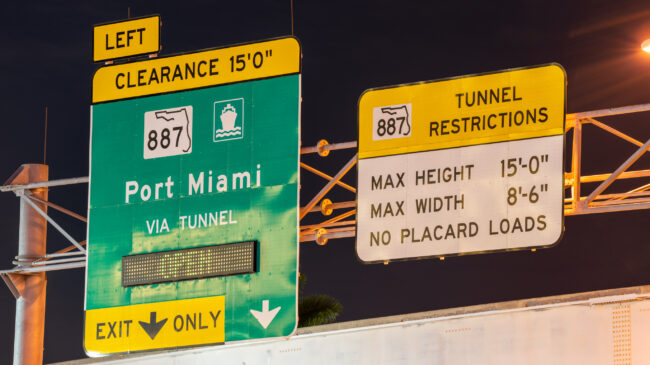Ten years ago, many people involved in the U.S. public-private partnership infrastructure world believed that the relatively new availability payment (AP) model was the wave of the future. It proved successful on two Florida public-private partnership (P3) megaprojects—the Port of Miami Tunnel and the reconstruction and widening of I-595 in Fort Lauderdale. It was seen as more attractive to bidders since there was no revenue risk, and operations and maintenance seemed to morph into simply hiring a specialized maintenance contractor.
According to a database of design-build-finance-operate-maintain (DBFOM) transportation P3s I’ve maintained since State Route 91 in California reached financial close in 1993, there have been 15 AP transportation projects since they began in 2009. But according to the same database, there have been 19 revenue-risk projects through 2021, with nearly all having reached financial close since 2009.
The big news in autumn 2022 is that about $16 billion in likely revenue-risk projects are in the pipeline. They include the $5 billion first phase of the Op Lanes Maryland project, three Atlanta express toll lane megaprojects at an estimated $7.3 billion, the $2.3 billion North Carolina I-77 extension project near Charlotte, and the $1.5 billion Calcasieu I-10 bridge replacement in Louisiana.
What is leading state transportation departments to re-embrace revenue-risk transportation public-private partnerships?
One reason is that their financial advisors have pointed out to them that a long-term commitment to a stream of availability payments is a liability on the state’s balance sheet. By contrast, the revenue bonds issued in revenue-risk P3 projects are non-recourse; state taxpayers are not at risk. Some states wisely count availability-payment obligations as part of their state debt limit. This limits how many such projects they can commit to.
Moreover, for projects that rely at least partly on user fees, revenue-risk P3 companies invest a lot more equity in their project than is typical of AP public-private partnerships; my data show the average AP concession has only 6.2% equity investment compared with 28.9% average in revenue-risk projects. The equity provides a cushion during times of recession, compared with all-debt or 93%-debt financing. Fitch Ratings recently increased its ratings of revenue-risk express toll lanes projects that came through the COVID-19 pandemic without missing their debt service payments.
Also politically relevant is that a given transportation megaproject requires less taxpayer support if done as revenue-risk. My information shows that the state departments of transportation (DOTs) (i.e., taxpayers) cover 33% of the cost of the average AP project but only 13% of the cost of the average revenue-risk project.
Those are all pragmatic reasons that help explain the return of revenue-risk public-private partnerships for megaprojects with a bondable revenue stream. But as a policy analyst, I like to focus on substantive reasons why revenue-risk P3s constitute better transportation policy, where they are feasible.
One of the most important of these is proper long-term stewardship of the highway, bridge, tunnel, airport terminal, etc., by the P3 company. The United States continues to have a large problem with deferred maintenance in many infrastructure sectors, including highways and transit.
In my book, Rethinking America’s Highways, I attribute this problem to the increasing politicization of infrastructure. Elected officials, whether in Congress or state legislatures, love to create ribbon-cutting opportunities for themselves, and building new infrastructure projects does that. In contrast, properly funding ordinary, ongoing maintenance does not come with ribbon-cutting ceremonies. So there is a built-in tendency to allocate taxpayers’ funds to new projects at the expense of proper ongoing maintenance. Some researchers call this the “ribbons vs. brooms” problem. A 50-year revenue-risk P3 builds in the proper long-term stewardship of the highway or bridge in question.
A less-understood benefit is that revenue-risk public-private partnerships also create a customer-provider relationship that is absent when the state builds and maintains a highway based on what the legislature decides. When I first started researching highway policy, I was surprised to learn that those who operate vehicles on highways are called “users,” not customers. (Only in the toll road sector are the vehicle operators called “customers” and are genuinely seen as such.) State DOTs apparently adopted this terminology because they are not paid directly by vehicle operators. Fuel tax revenues are paid to the state, and the legislature allocates them to the state DOT as it sees fit. In other words, the DOT’s de-facto customer is the legislature—that is who pays its bills, and that is whom it must satisfy.
In other words, a 50-year P3 highway, bridge, or tunnel is a business, serving and accountable to its customers. We have seen P3 companies make significant changes in a DOT’s preliminary design, to make an express toll lane project more accessible to potential customers. Others have come up with design changes that reduce construction costs, getting more bang for the investors’ bucks and by reducing the project’s construction cost, somewhat reducing the toll rates needed to provide a return on the investment. This model is similar to investor-owned electric, gas, and water utilities, which also have customers, not “users.”
To be sure, as I acknowledge in my book and policy papers, there are cases where an availability-payment model makes sense. If tolls are not feasible (e.g., the Port of Miami tunnel), if there is no realistic bondable user-fee revenue stream (rail transit), or if the toll revenue would be far too little (Pennsylvania’s Rapid Bridge Replacement Project), the AP model offers real benefits. It shifts construction and late-completion risks and provides guaranteed long-term maintenance, so it’s superior to traditional design-bid-build and design-build models for transportation megaprojects.
I’m not surprised by the resurgence of the revenue-risk model in recent years. With such an array of potential megaprojects in coming decades—including replacing much of the nation’s worn-out Interstate highway system and replacing major bridges that are functionally obsolete and/or structurally deficient—the stewardship and user-funded benefits of this model suggest it will continue to be in demand.
A version of this column first appeared in Public Works Financing.

